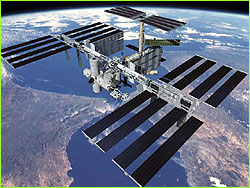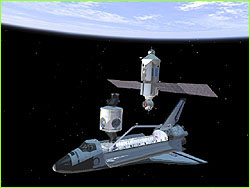
|
 |
 |
by Peter Tyson It has been described as "the largest international scientific and technological endeavor ever undertaken [which will light] the pathway for peaceful cooperation between nations in the 21st century." It has also been described as a "colossally expensive celestial turkey, for which no rational purpose has been expressed by even its most enthusiastic supporters." Ever since it was first proposed by U.S. President Ronald Reagan in 1984, the International Space Station (ISS) has attracted such superlatives. Perhaps that's because it's a creature of superlatives itself (see A Station Second to None). However you may perceive it, the ISS is a reality. On November 20, 1998, if all goes to plan, a Russian Proton rocket will lift off from the Baikonur space base in Kazakhstan carrying the first 20-ton module of a planned 520-ton space station. Known as the Functional Cargo Block, or FGB for its Russian acronym, this first module will serve as a power and propulsion unit to keep the station's early components in position. The FGB will be followed by Unity, a pressurized module lofted aboard the Space Shuttle that will link with the FGB and later with future components. Currently set for an April 1999 lift-off, the Russian-built third element, the prosaically named Service Module, will contain living quarters, navigation and life-support systems, and rocket boosters to periodically nudge the fledgling station back into its proper orbit. Other Russian- and American-built modules and solar panels will follow in the coming years. The other 14 nations involved in the project will send up their own contributions. Canada will provide a robotic arm to help construct and maintain the station, while Japan will build a lab module with a "back porch," where experiments can be exposed to space. Italy—a member of the European Space Agency, which is supplying a research module to be flown aboard its Ariane V launch vehicle—is designing resupply vessels to be flown aboard the Space Shuttle. These will bring food, equipment, and new scientific experiments. Brazil, the only developing country participating in the endeavor, is creating a special optical window for the study of hurricanes, deforestation, and other environmental phenomena on Earth.
Promoting international cooperation is just one of the many goals the station's backers envision for this "orbiting science institute," as NASA deems it. Foremost among them, of course, is scientific research. Station crews will grow protein crystals to help enhance drug design and research into disease treatment, and conduct experiments to improve the design of polymers and semiconductors. They will study the growth of plants, which is essential for long space habitation. (ISS proponents see the station, among other things, as a stepping stone for manned exploration of Mars.) Finally, they will serve as guinea pigs in a study of the human response to long-duration exposure to zero-g. Other goals are more ephemeral, as perhaps befits an undertaking taking place in outer space. A NASA fact sheet lists them succinctly:
A Station Second To None Rank after the Moon and Venus in brightness in night sky when complete: 1 Number of Boeing 747 passenger cabins its work and living space will equal in size: 2 Approximate breadth when fully assembled, in football stadiums: 1 Approximate weight when fully assembled, in pounds: 1 million Maximum number of people who will be able to live on it at once: 7 Longest planned stay for a single individual: 187 days Gravitational force on it compared to that on Earth: 1 millionth Speed at which it will orbit Earth: 18,000 mph Time it will take to orbit Earth: 90 minutes Miles above the Earth it will orbit: 250 Percentage of the Earth's surface it will be able to observe: 85 Year it was first proposed by President Ronald Reagan: 1984 Year by which he hoped to have it fully operational: 1994 Year it is currently slated to be fully operational: 2004 Rank in size of global scientific projects during peacetime: 1 Number of nations involved in its construction and operation: 16 Estimated number of jobs in Russia alone its design and operation will provide: 100,000 Planned number of shuttle and rocket launches to construct: 45 Number of hours of spacewalks needed during construction: 1,729 Number of times which this figure exceeds all spacewalks ever done: 2 Total estimated cost to develop and operate through the year 2027, according to the U.S. Government Accounting Office: $118 billion Official minimum life expectancy: 10 years Peter Tyson is Online Producer of NOVA. Images: NASA Q&A | Tour of Mir | Day in the Life Next Space Station | Mishaps | Resources Teacher's Guide | Transcript | Site Map | Terror Home Editor's Picks | Previous Sites | Join Us/E-mail | TV/Web Schedule About NOVA | Teachers | Site Map | Shop | Jobs | Search | To print PBS Online | NOVA Online | WGBH © | Updated November 2000 |
 Rendering of the International Space Station
Rendering of the International Space Station
 Rendering of Space Station assembly.
Rendering of Space Station assembly.